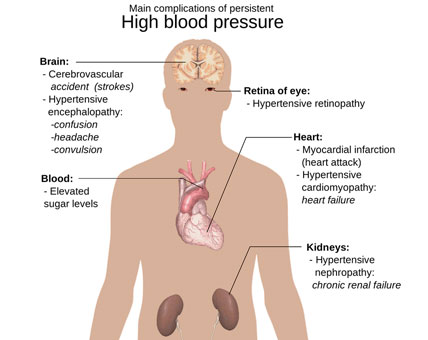Sodium Increases Risk of High Blood Pressure
In the body, sodium plays an essential role in regulation of fluids and blood pressure. Many studies in diverse populations have shown that a high sodium intake is associated with higher blood pressure. Most evidence suggests that many people at risk for high blood pressure reduce their chances of developing this condition by consuming less salt or sodium. Some people are more sensitive to salt than others and those people are four times more likely to develop hypertension. Those people who are salt sensitive should cut down on their salt intake or they are at greater risk of developing hypertension. Whenever possible, as with fat and cholesterol, everyone should try to limit their salt intake.
What do excess amounts of salt do to the body?
Salt is a compound containing two minerals, sodium and chloride and it attracts water. When the salt content of your blood goes up, it attracts water from around your cells (in muscles and organs) into your blood to dilute it. Otherwise, your blood would be too salty. There is salt as sodium outside every cell in your body. When the salt content of the fluid around your cells is increased, it attracts water from your blood that causes swelling.

Your kidneys work to regulate salt and water levels in your body. When salt and water levels increase around cells, the excess is drawn into your blood, which is filtered by your kidneys. Your kidneys remove excess salt and water from your blood, both of which are removed in the form of urine. When your kidneys don’t work well, fluid builds up around cells and in your blood. If there is more fluid in your blood, your heart has to work harder and your blood pressure can go up because there is more pressure on the walls of your blood vessels. This can weaken your heart.
Tips to lower blood pressure
If you have been diagnosed with high blood pressure, you should be limiting foods high in sodium and lose weight. How much you should restrict sodium in foods you eat depends on what your doctor recommended.
Generally, you should eat fresh, unprocessed foods, not add salt to your food after cooking and only add half the salt in a recipe. This level would be called a mild salt restriction (3,000 to 4,000 mg sodium). You probably should not use a salt substitute (potassium chloride) or reduced salt either.
Sodium and salt are high in processed and prepared foods
Sodium and sodium chloride, known commonly as salt, occur naturally in foods, usually in small amounts. Salt and other sodium-containing ingredients are often used in food processing. Most dietary sodium or salt comes from foods to which salt has already been added during processing or preparation. Although many people add salt to enhance the taste of foods, their preference may weaken with eating less salt.
Foods to avoid
Note: Some of these foods can be found with lower or reduced sodium levels. Check nutrition labels.
a.) Fast foods
b.) Canned vegetables & soups
c.) Ham, bacon & sausages
d.) Hot dogs
e.) Pickles & olives
f.) Salted nuts, chips & crackers
g.) Bullion cubes
h.) Worcestershire & Soy sauce
Some vegetables are high in sodium
Celery is the highest in sodium and contains 35.2 milligrams of sodium in one stalk. Other vegetables that are high and should be limited to 1/2 cup per day are: beets; beet greens; carrots; dandelion greens; kale; mustard greens; spinach; Swiss chard; white turnips; frozen peas; frozen lima beans; tomato juice, sauce, paste or puree. The sodium values range from 35 to 155 milligrams for one cup cooked of any above vegetable. Instead of these vegetables, try green pepper, green onions, cauliflower or broccoli for munching.
These vegetables do not taste salty compared to ham (one cup chopped has 2000 mgs sodium). Also, they are not usually omitted from mild salt restricted or even low salt diets. People on diets of less than 1,000 milligrams are usually instructed to limit or omit beets, carrots, celery and spinach from their diet. Small amounts of these vegetables, used to flavor soups or stews, are not usually omitted even on low sodium diets
